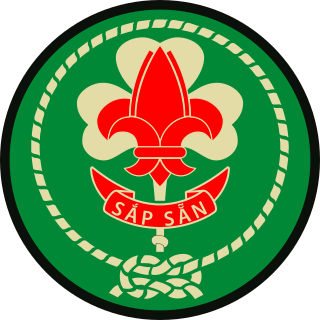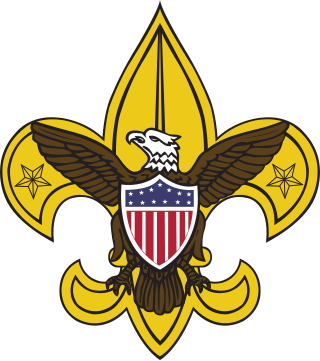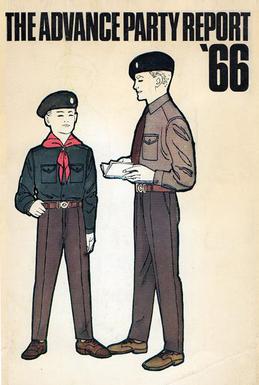
A Scout is a child, usually 10–18 years of age, participating in the worldwide Scouting movement. Because of the large age and development span, many Scouting associations have split this age group into a junior and a senior section. Scouts are organized into troops averaging 20–30 Scouts under the guidance of one or more Scout Leaders or Scoutmasters. Troops subdivide into patrols of about 6–8 Scouts and engage in outdoor and special interest activities. Troops may affiliate with local, national, and international organizations. Some national Scouting associations have special interest programs such as Air Scouts, Sea Scouts, outdoor high adventure, Scouting bands, and rider Scouts.

Advancement and recognition in the Boy Scouts of America is a tradition dating from the inception of the Scouting movement. A fundamental purpose of advancement is the self-confidence a young man or woman acquires from his participation in Scouting. Advancement is one of the methods used in the "Aims and Methods of Scouting"– character development, citizenship training and personal fitness.

Cub Scouts, Cubs or Wolf Cubs are programs associated with Scouting for young children usually between 7 and 12, depending on the organization to which they belong. A participant in the program is called a Cub. A group of Cubs is called a "Pack".

Scouts Canada is a Canadian Scouting association providing programs for young people, between the ages of 5 and 26, with the stated aim "To help develop well rounded youth, better prepared for success in the world". Scouts Canada, in affiliation with the French-language Association des Scouts du Canada, is a member of the World Organization of the Scout Movement. In 2021–22, youth membership stood at 33,899, a 48% decline from 64,693 in 2014–15. Over the same period, volunteer numbers also declined 43%, from 20,717 in 2015 to 11,765 in 2022. Scouts Canada has declined significantly in size since its peak: youth membership is down 82% from 288,084 in 1965 and volunteer numbers are down 50% from 33,524 in 1965.

Founded in 1908, The Scout Association of Malta (TSAM) is the Scouting organization in Malta. TSAM has always maintained a high and respectable Scouting tradition. Its leaders and members are committed to further the ideals of Scouting in line with those as traditionally established by the youth movement's Founder, Lord Robert Baden-Powell of Gilwell, and as further developed by the World Organization of the Scout Movement (WOSM). TSAM is a forward looking youth movement which, as a non-governmental organisation (NGO), enjoys great respect both locally and internationally. It is the only association in Malta which is recognised by the WOSM, and is also a member of the European Scout Region.

Scouts South Africa is the World Organization of the Scout Movement (WOSM) recognised Scout association in South Africa. Scouting began in the United Kingdom in 1907 through the efforts of Robert Baden-Powell and rapidly spread to South Africa, with the first Scout troops appearing in 1908. South Africa has contributed many traditions and symbols to World Scouting.
Scouting and Guiding in mainland China was reported as banned with the establishment of the People's Republic of China (PRC) by the Communist Party since 1949. Instead, the Young Pioneers of China and the Communist Youth League, led by the Communist Party, have become the dominant youth organization in mainland China for younger and older youth, respectively. However, China now has multiple and originally separate Scouting activities within its borders. In 2004, the Scout Club of Hainan (海南童子军俱乐部), borrowing heavily from Scouting in terms of emblems, uniforms and activities, was founded in Hainan Province; it is, however, not affiliated with worldwide Scouting. An attempt to organize a nationwide Scouting organization in Wuhan was ended by the government in 2004. The Scout Association of the People's Republic of China (中华人民共和国童军总会), founded in 2008 serves Venture Scouts in both genders as well as Rover Scouts. The Rover Explorer Service Association operate groups in China.

The Vietnamese Scout Association is a youth organization that was established in Vietnam and active between 1930 and 1975. The association was recognized by the World Organization of the Scout Movement from 1957 to 1975.

The Bangladesh Scouts is the national Scouting organization of Bangladesh. Now The Chief Scout of Bangladesh is MD Shahabuddin. Scouting was founded in 1914 in East Bengal, now Bangladesh, as part of the British Indian branch of The Scout Association, and continued as part of the Pakistan Boy Scouts Association until the country's divided sections split in 1971 during the Bangladesh Liberation War. Following its independence, in 1972, the Bangladesh Boy Scout Association was officially formed as successor of the Pakistan Boy Scouts Association. Bangladesh became an independent member of the World Organization of the Scout Movement in 1974. The organization changed its name to "Bangladesh Scouts" in 1978. The organization has 2,261,351 members as of 2021.

A Scout leader or Scouter generally refers to the trained adult leader of a Scout unit. The terms used vary from country to country, over time, and with the type of unit.
Scouting started in Victoria, Australia, as early as 1907 and local Boy Scout patrols and troops formed independently. Several separate central organisations began operating including Boys' Brigade Scouts, Church Lads' Brigade Scouts, Chums Scouts, Imperial Boy Scouts, Girl Peace Scouts, Imperial Boy Scouts Victoria Section, Imperial Boy Scouts Victorian Section, Gippsland Boy Scouts Association, Australian Boy Scouts, Australian Imperial Boy Scouts, The Boy Scouts Association, Life-Saving Scouts of the Salvation Army and Methodist Boy Scouts.

Scouts BSA is the flagship program and membership level of the Boy Scouts of America (BSA) for boys and girls between the ages of typically 11 and 17. It provides youth training in character, citizenship, and mental and personal fitness. Scouts are expected to develop personal religious values, learn the principles of American heritage and government, and acquire skills to become successful adults.

The Boy Scouts of America (BSA) was inspired by and modeled on The Boy Scouts Association, established by Robert Baden-Powell in Britain in 1908. In the early 1900s, several youth organizations were active, and many became part of the BSA.

Samoset Council is a Boy Scout council headquartered in Weston, Wisconsin that serves north central Wisconsin. Founded in 1920, the council gets its name from an early Boy Scout camp in the Town of Harrison named Camp Sam-O-Set. The council is served by Tom Kita Chara Lodge of the Order of the Arrow.

A Scout troop is a term adopted into use with Boy Scouts, Girl Scouts and the Scout Movement to describe their basic units. The term troop echoes a group of mounted scouts in the military or an expedition and follows the terms cavalry, mounted infantry and mounted police use for organizational units.

The Boy Scouts Association's The Chief Scout's Advance Party Report 1966 attempted to address the association's falling enrollment numbers and modernise its programs. It resulted in changes to traditional iconic uniforms, changes to awards, training schemes, the association's name and other nomenclature, reduced distinctions between Cubs and Scouts and discontinuation of Rovers. However, the changes failed to halt decline in older enrolments, resulting in a shift to younger ages and also resulted in disaffection, a schism in the organisation, growth of the alternate British Boy Scouts and European Scout Federation, formation of independent Scout groups and further alternate Scout organisations, particularly the Traditional Scouting Baden-Powell Scouts' Association and helped to re-establish understanding of Scouts as a movement rather than a single organisation.

Scouting and Guiding in Gibraltar exist as branches of the parent organisations in the United Kingdom.
The Scouter's Training Award is an adult recognition of the Boy Scouts of America. This award is available across several different program areas and can be earned more than once.

In the Boy Scouts of America, a Scout leader refers to the trained leaders of a Scout unit. Adult leaders are generally referred to as "Scouters," and the youth leaders are referred to by their position within a unit. In all Scouting units above the Cub Scout pack and units serving adolescent Scouts, leadership of the unit comprises both adult leaders (Scouters) and youth leaders (Scouts). This is a key part of the Aims and Methods of Scouting. In order to learn leadership, the youth must actually serve in leadership roles.

The Outdoor Service Guides (OSG) is an inclusive, co-ed scouting organization in the United States. It accepts scouts without regard to gender, gender identity, race, sexual orientation, economic circumstances, religion, or other differentiating factors. OSG is a member of the World Federation of Independent Scouts (WFIS).


















